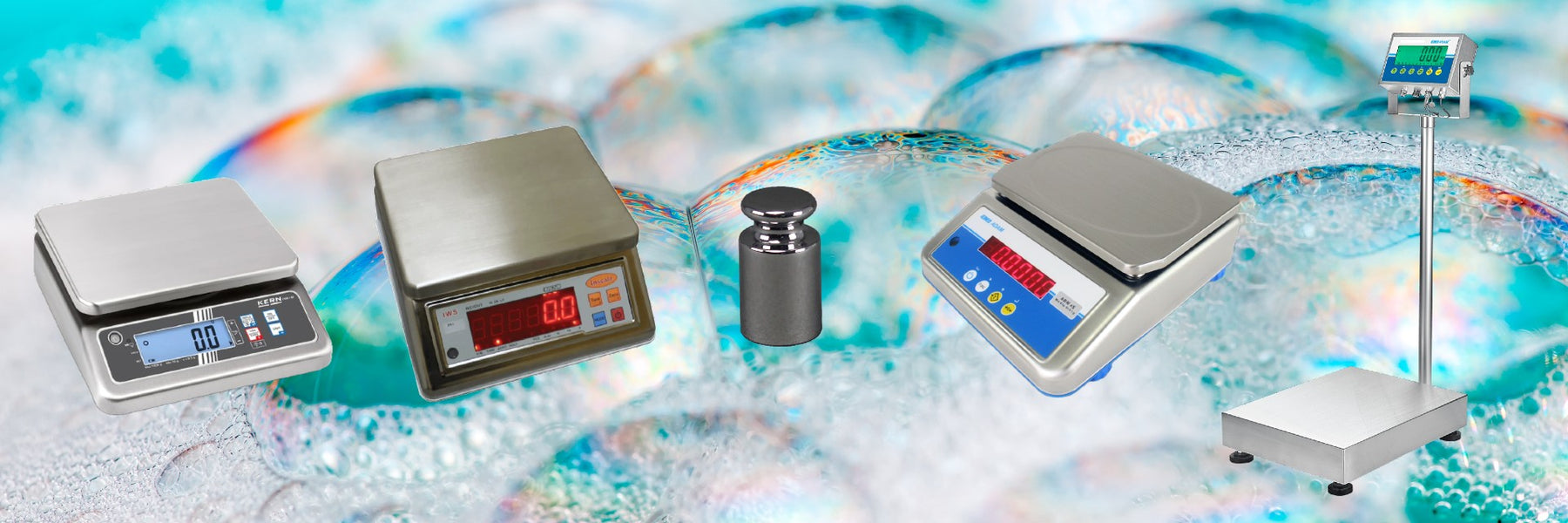
Waterproof Scales Maintenance: How to Look After Your IP67 and IP68 Scales
Thanks to washdown and waterproof scales’ superior protection, it’s easy to believe that regular maintenance isn’t as necessary. However, if you want your scale to last as long as possible, this blog will provide guidance on how to properly maintain, clean, and even use your waterproof scale.
Understanding IP67 and IP68 Scales
First things first, what does IP67 and IP68 mean? IP67 rated scales are considered washdown scales, with full resistance to ingress from solids like dirt or dust, with protection from water for up to thirty minutes at depths of up to one metre. IP68 rated scales (and above, up to IP69) are fully waterproof, as they offer not only full resistance to solids but also complete protection from submersion up to one and a half metres, for long periods of time. IP68 scales can also handle pressure washes, though only IP69 scales are able to withstand high temperature jets at close range.

To learn more about the difference between washdown and waterproof scales and when you would choose to use them, read our recent blog. Understanding the difference is crucial when performing maintenance on your washdown or waterproof scales.
When is it Time for Cleaning?
How can you tell when it’s time to clean and maintain your IP67 or IP68 scale? Based on your frequency of use for the washdown scale and its specific applications, ensure regular cleaning and general maintenance, ideally performed daily.
When your scale doesn’t physically look dirty, you may decide to put off cleaning until the next day. However, not all ‘dirt’ is visible to the human eye. Let’s say you spent a long day weighing fresh meat on your scale for sandwiches. Your deli shop is finally closed, the meat put away, and your washdown scale looks clean. So, you decide to put it off, and go home. The next day, you begin weighing meat once again. What you don’t know is that bacteria have begun developing on your weighing pan overnight, and you’re contaminating all future products.
Moral of the story, even when your scale looks clean, if you’ve been weighing items that come into direct contact with the pan, a quick scrub is necessary at minimum.
Cleaning Techniques
Your scale is dirty or wet and needs a wash. The manufacturer may have specific recommendations for cleaning included in the manual, but generally, this is how you’ll want to go about it. The first step is to prepare your cleaners. You don’t need harsh chemicals to get your scale clean, in fact gentle, mild cleansers are more effective. By using a mild detergent, you’re mitigating the risk of causing damage over time if you wash your scale frequently. Of course, the type of gentle cleanser you use will also be determined by your work environment. For example, you may need a food-safe cleanser for your butcher shop or bakery.

The second step is to remove the weighing pan. The pan doesn't sit flush against the scale itself, allowing water and cleanser to potentially get underneath and be overlooked during washing or drying. Removing it preemptively reminds you to clean underneath.
When it comes time to begin cleaning, consider whether it’s necessary to fully submerge your scale in water. Even if it is IP67 or IP68 rated, most of the time, it won’t be needed. Simply rinse your scale with water, scrub it with firm but gentle pressure all around with your cleanser. Then, rinse it again to remove the soap and debris.
Wipe your scale down with a microfibre towel to dry or leave it to air-dry completely before next use. Your scale will still operate when wet, but the weight of water on the pan may impact your weighing results, or creep into the items you’re weighing. For more detail, check out Adam Equipment’s blog here.
Your washdown or waterproof scale is now shiny, clean, and ready to get back to work.
An Important Safety Measure
We all know that electricity and water don’t mix. However, your waterproof scale comes with a cord and plug for charging. So, it must be safe to keep it plugged in while washing, right? No! You may use the cord while the scale is dry to weigh other dry items or to charge overnight. Rely solely on the internal rechargeable battery when actively using the scale to weigh dirty or wet items. Likewise, when you’re washing it down afterwards. The plug itself should never encounter water. Not only does this keep you safe from any electrical mishaps but increases the longevity of your scale as well.
Calibration Importance and Frequency
Another large part of general waterproof scale maintenance is calibration. This helps guarantee that your results are accurate over time. Aim for a regular calibration schedule, such as every few months, or a minimum of twice a year. If you notice that your results are beginning to grow inconsistent, or they’re drifting, that’s a sign that calibration should be performed. Ideally, though, you would calibrate frequently enough that your scale would never get to that stage.

Best Practices
To get the best use of your IP67 or IP68 washdown scale, you need to consider their limitations and treat them accordingly. For example, only an IP68 would be suitable for 24/7 use outdoors, especially in harsh weather conditions. Ideally, your scale will be on a flat, stable surface, away from direct sunlight and any other major disturbances, such as vibrations and static. For more information, see how you can help guarantee accurate results every time with these six tips.
Have some questions or are wondering which washdown or waterproof scale is best for you? Contact the Inscale team for assistance.

Leave a comment